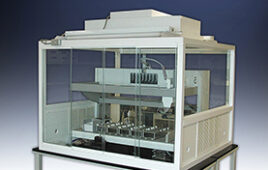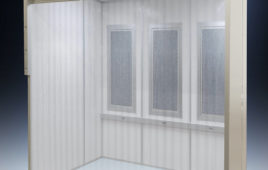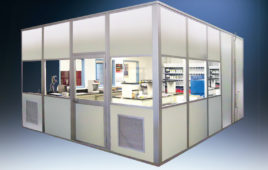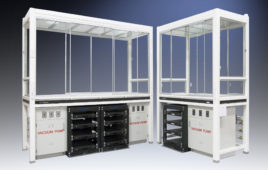Those working in controlled environments such as laboratories and cleanrooms may encounter a variety of hazards, including exposure to potentially harmful pathogens. This exposure can occur in a variety of ways, including inhalation of pathogens, ingestion, or by touching a contaminated surface.
In fact, touching a contaminated surface is typically the most common way pathogens are spread. Some can enter the body through the skin or, in the form of cross-contamination, become an issue after someone has touched a contaminated surface and then touched their eyes, nose, or mouth.
Since the 1980s, and as a result of the HIV epidemic, controlled environments and laboratories around North America have beefed up their efforts to prevent exposure to harmful pathogens and protect the health of laboratory workers. Often this has involved the wearing of more — and more effective — protective gear. These efforts have paid off. Since 1999, there has only been one confirmed case of “laboratory-acquired infection,” as a result of exposure to HIV.1
Further steps have also been taken. For instance, the way laboratories perform many tests has changed over the years. More tests are now performed using automated methods, which require less physical touching and handling of potentially harmful materials. These have replaced the more traditional, manual testing of laboratory samples.
However, fears and concerns about laboratory-acquired infections escalated with the Ebola epidemics, which began in 2013. People infected with this disease often require ongoing laboratory testing including regular blood counts, coagulation testing, electrolyte analysis, etc. This meant that laboratory workers were continually handling blood samples, putting themselves at ongoing risk of contracting Ebola when working with these patients.2
It was also found that laboratory workers could also potentially be at risk of contracting other infectious diseases in the process — infections that have overlapping symptoms such as malaria, influenza, and bacteremia. Compounding concerns and anxiety, when the Ebola outbreaks first occurred many North American laboratory workers were unsure of the safest approach to test these samples.
To address these issues, the Centers for Disease Control and Prevention (CDC), recommended that laboratories perform “risk assessments.” This could help reduce or eliminate the possibility that laboratory staff might come down with Ebola or a similar serious disease.3
A risk assessment can involve many things, including testing surfaces — everything from laboratory equipment to counters, chairs, walls, floors, and tables — to see if pathogens are present. In the professional cleaning industry, a risk assessment is often referred to as a “surface assessment.”
The procedures suggested by the CDC involved swabbing surfaces in the laboratory area and then waiting for the results. While the process could be slow, ultimately it did determine if potentially harmful pathogens were present, the types of pathogens, and once identified, staff could take steps to eliminate them, typically through effective cleaning.
Growing use of surface assessments
Surface assessments like this are now being performed in all types of settings — not just laboratories and not just under emergency circumstances such as the Ebola outbreaks. For instance, recently in Canada two people contracted Hepatitis C. When public health inspectors investigated the situation, they found that the two people were both patients of the same dental clinic. Although the clinic is defending its cleaning and sterilization practices, reporting that their sterilization procedures meet or exceed those required of dental surgeons in this part of Canada, other dental clinics are now calling in surface assessment services to inspect and determine if pathogens that could cause infections might be present in their clinics.
Traditionally, this involves the use of ATP (adenosine triphosphate) swabs, but this is now being accompanied by or supplanted with new imaging technologies. Using these technologies, technicians evaluate a variety of surfaces — those considered “high-touch,” which are often contaminated; and those less frequently touched. Images then reveal if microbes are present and indicate precisely where they are using something called “special specificity.” They serve as a warning sign that these could be potentially harmful to health.
As an example of what can be uncovered — sometimes to the surprise of office managers and/or health and safety administrators — in one dental clinic, a surface assessment service was conducted and uncovered the following:
Exam rooms: In general, numerous areas in the exam rooms were potentially contaminated to varying degrees.
Refrigerator door handle: A high touch area; however, only small amounts of contamination were found on the door handle.
Ceiling vents and HVAC systems: High levels of contamination were indicated. This was unexpected, and the clinic did not know when these areas were last cleaned.
Staff room: High contamination readings were indicated on several high touch surfaces in the staff room.
On-site cleaning equipment: A high potential for cross-contamination was possible in this clinic because the cleaning tools and equipment (mops, brooms, etc.) were found to be contaminated.
These examples and the incidents discussed here should encourage administrators in controlled environments, laboratories, cleanrooms, and beyond to conduct surface assessments and ensure their facilities are adequately disinfected. How frequently these assessments should be deployed is dependent on, among other things, the health risks that laboratory workers may encounter working in the laboratory. However, they must be performed frequently enough so that administrators can create a “culture of safety” for their staff — ensuring they can perform their work without the risk of contracting a laboratory-acquired infection.
References
1. Joyce, P., et al. “Notes from the field: occupationally acquired HIV infection among health care workers — United States, 1985-2013.” Medscape 2015
2. Lyon, G.M., A.K. Mehta, J.B. Varkey, K. Brantly, L Plyler, A.K. McElroy, et al. “Clinical care of two patients with Ebola virus disease in the United States;” New England Journal of Medicine; Dec. 18, 2014
3. “Interim guidance regarding compliance with select agent regulations for laboratories handling patient specimens that are known or suspected to contain Ebola virus.” Centers for Disease Control
Brad Evans is general manager of Optisolve, a surface assessment service that allows administrators to be proactive and validate that the money being invested in cleaning is delivering on the goal of keeping facilities clean and healthy. [email protected]; www.optisolve.net




